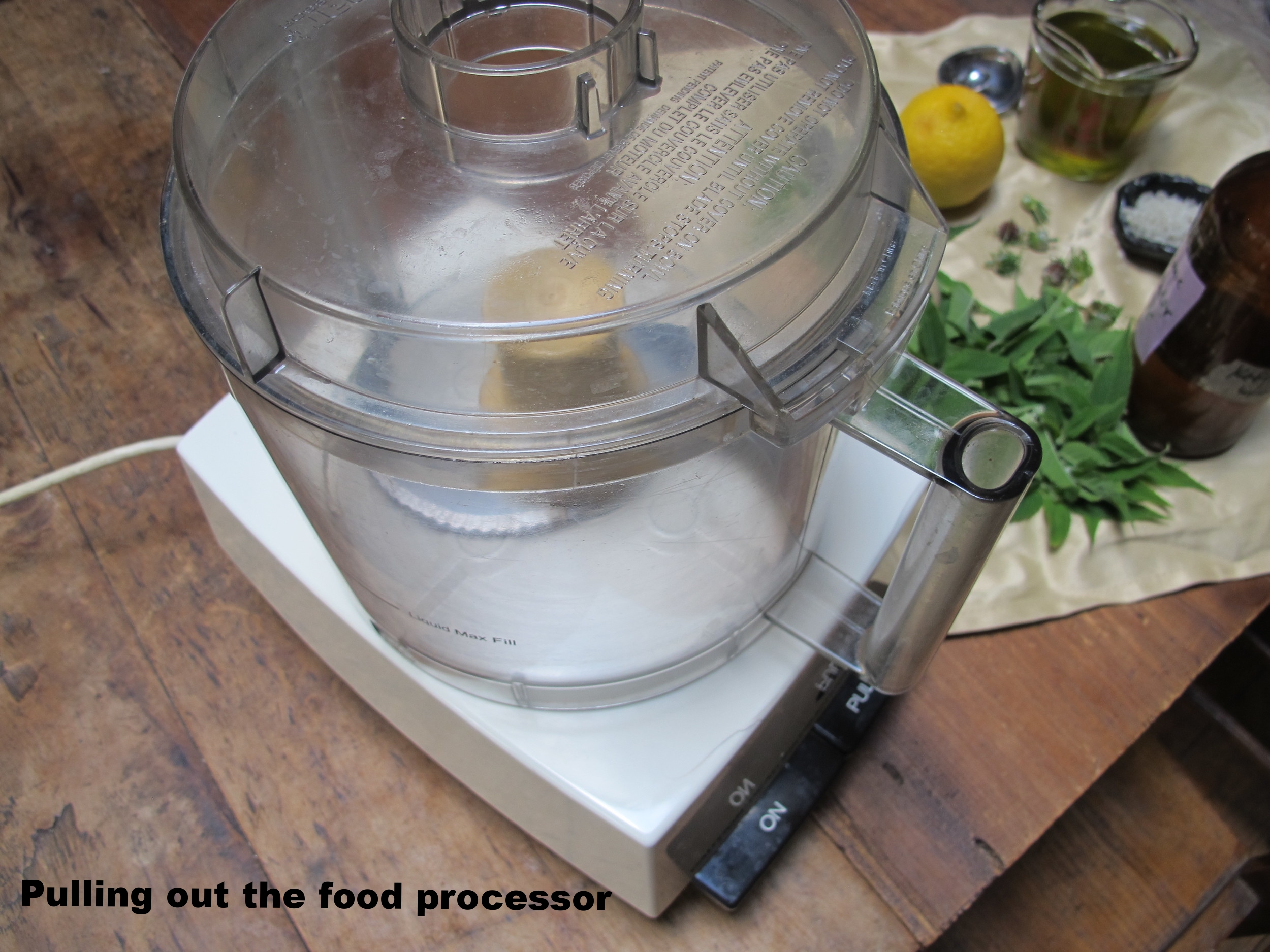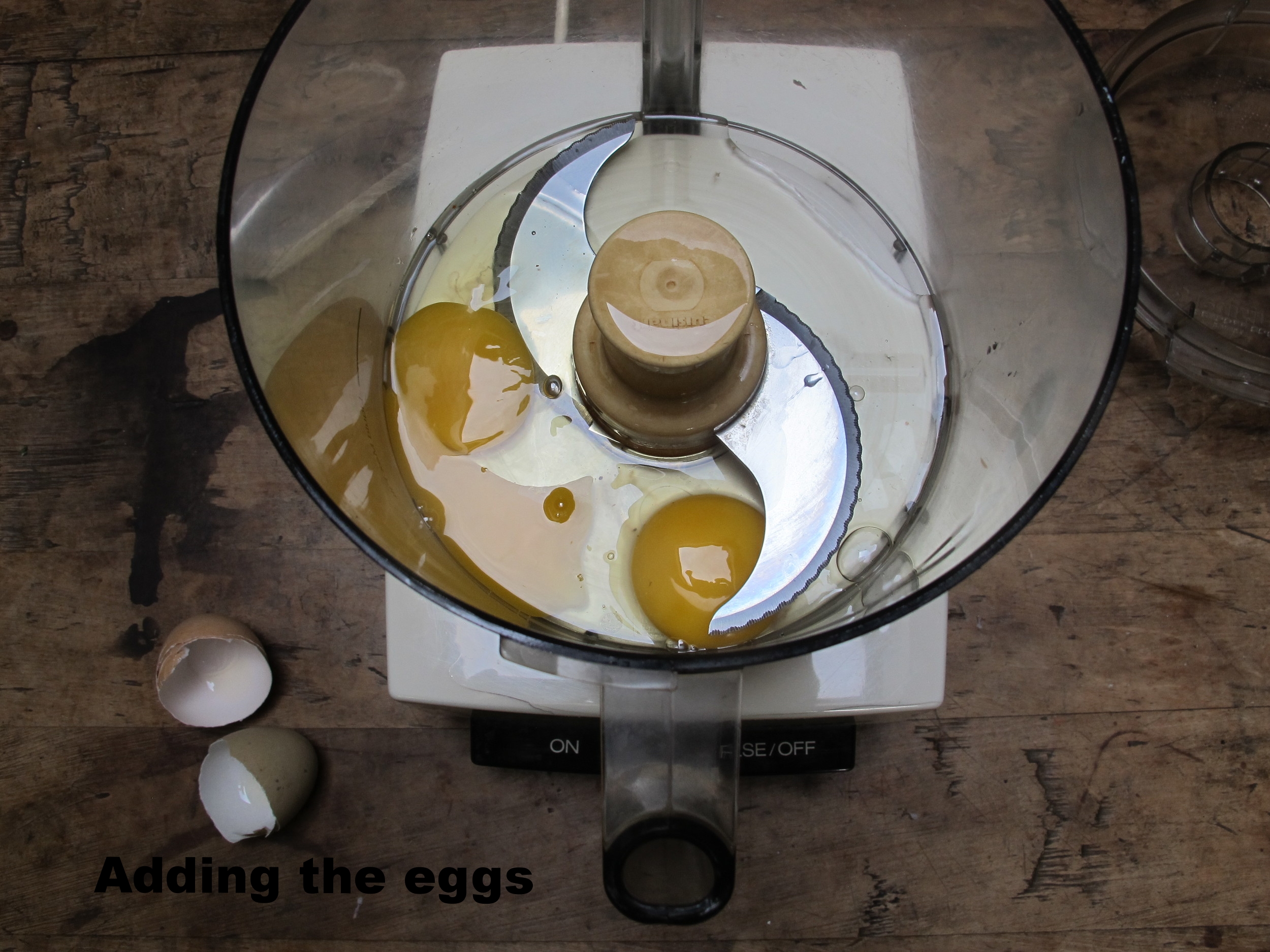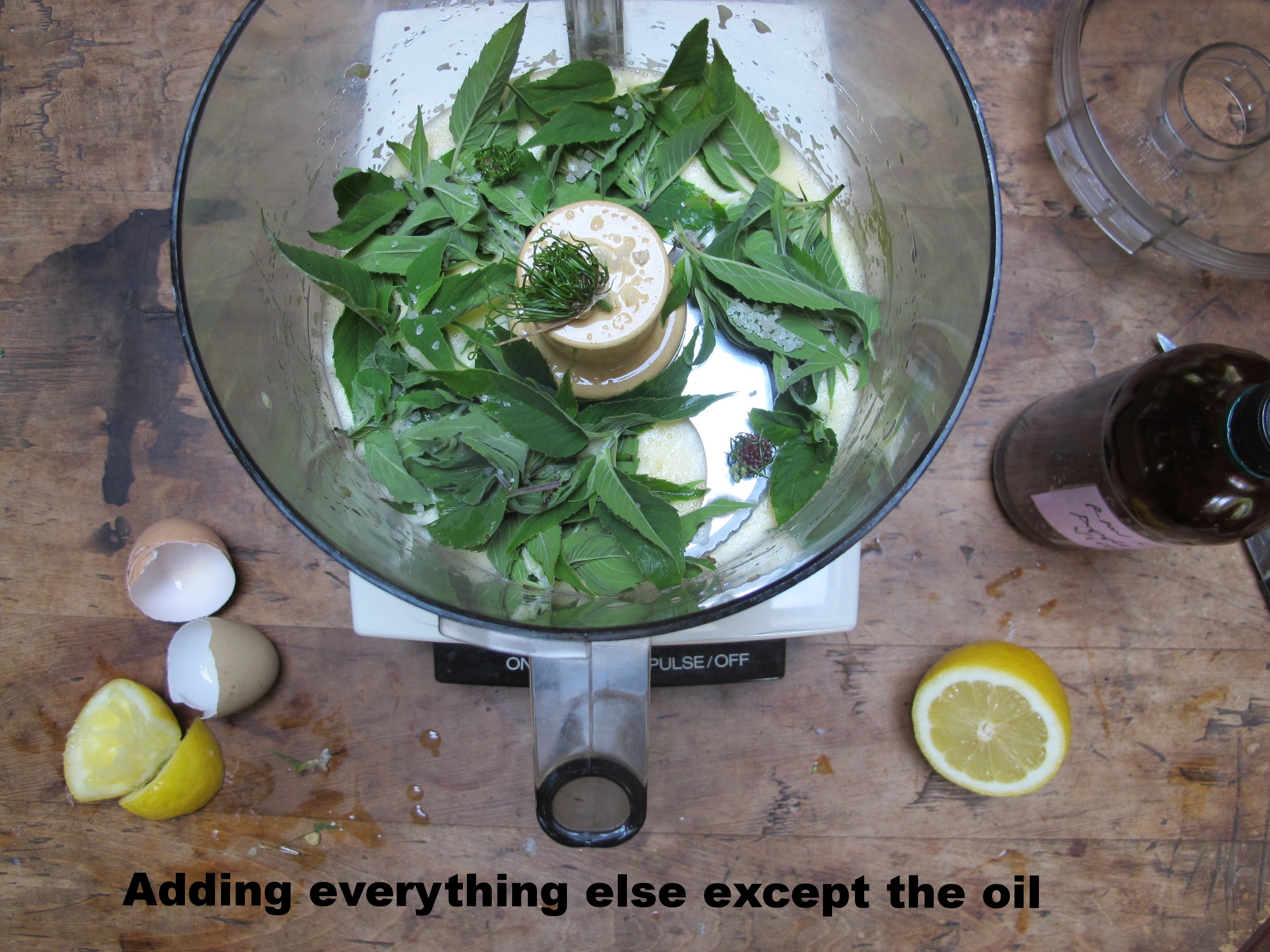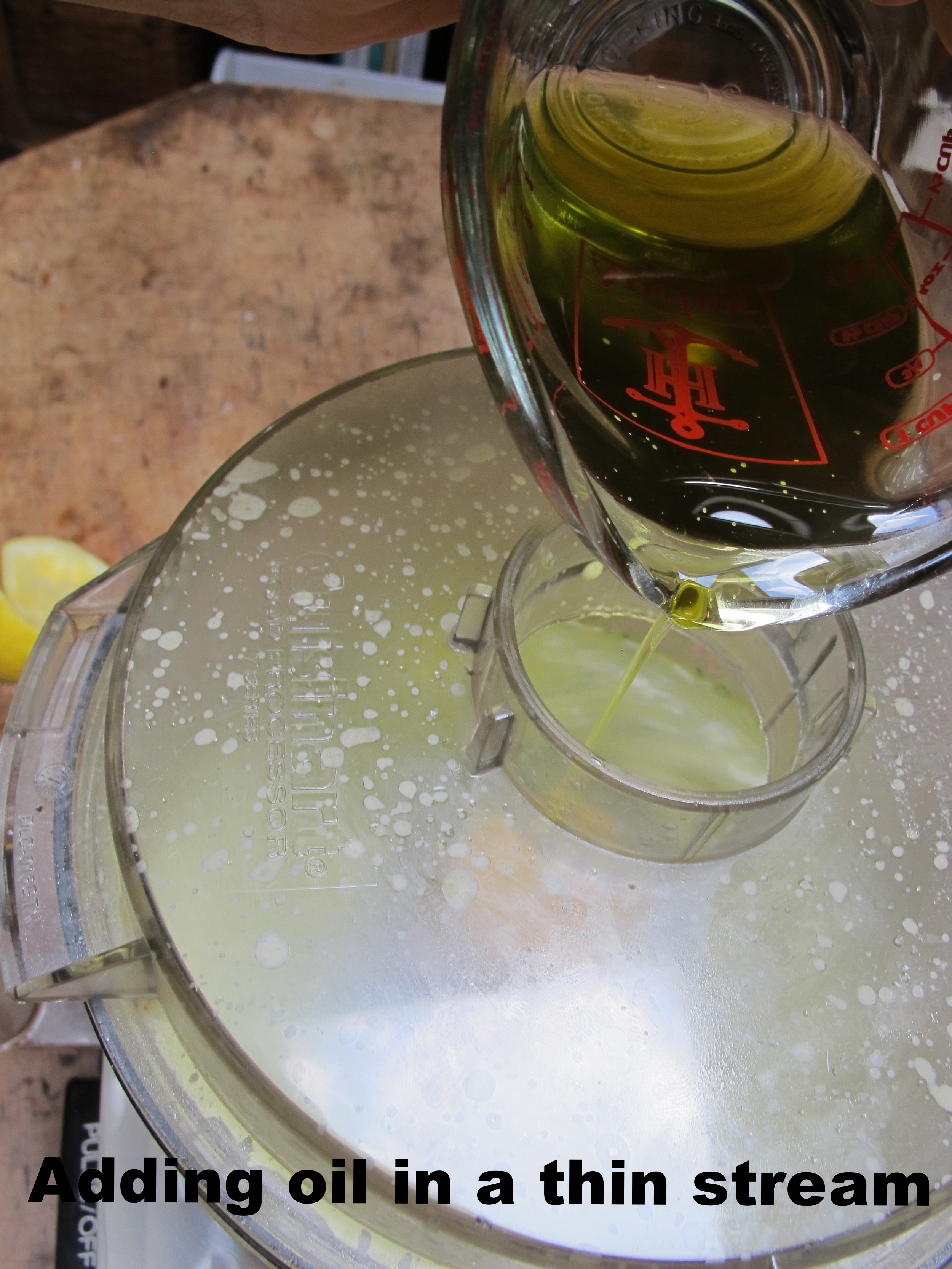I find it extremely satisfying to blend up my own mayonnaise and I especially love to include the seasonal flavors of the field. Today's version is made with 3 tablespoons wild bergamot leaves and 3 field garlic bulbets that have just emerged, making it even more delicious! I use whole eggs in this batch resulting in a lighter, thinner mayo. I am excited to share my master recipe here with you and hope that it will unleash your mayo-making talent. Please let me know how your mayonnaise turns out in the comments.
Mayonnaise Master Recipe, Makes 1 1/4 cups (10 oz)
Blended with high quality ingredients, homemade mayonnaise is a healthy alternative to the store-bought stuff. It is quite easy to make with a food processor; just be sure that all the ingredients are at room temperature. Additionally, by including various herbs and flavor accents, you can whip up some seriously tasty variations to enliven sandwiches or serve as delectable dipping sauces for meat, fish, veggies, and more. Keep in mind that cold-pressed, unrefined oils — the kind you want to use — have a strong flavor and will influence the taste of the mayonnaise, in a good way. If you use a lot of mayonnaise, you may want to double or triple this recipe.
All the ingredients you need to make your own mayo plus wild bergamot leaves and field garlic bublets that feature in today's recipe.
Make sure all ingredients are at room temperature:
- 2 fresh free-range organic eggs yolks
- 1 tablespoon lemon or lime juice
- 1 tablespoon vinegar (preferably raw, unfiltered, organic apple cider)
- ½ teaspoon sea salt
- Optional: 1 tablespoon Whey
- 1 cup oil (preferably organic, cold pressed olive oil)
- Place egg yolks in food processor and blend for 30 seconds.
- Add lemon juice, vinegar, salt and optional whey and blend for 15 seconds.
- With food processor running, add 2 tablespoons of oil in little dribbles.
- Pour the rest of the oil into food processor in a thin stream.
- Continue to whip the mayonnaise in food processor for 3–4 more minutes to ensure a good emulsion.
- Scoop mayonnaise into a very clean jar. Tightly cap and label the jar, then store in refrigerator where it will keep for at least two months. (I made one with whey that so far has kept for three months.)
- If using whey, allow the mayonnaise to lacto-ferment by leaving it out at room temperature for 7 hours before storing in refrigerator.
Variations:
Lighter Mayonnaise: Using whole eggs in place of the egg yolks produces a lighter, thinner mayonnaise.
Flavor Accents: Add the following ingredients along with the lemon juice, vinegar and salt.
- To sweeten the mayonnaise, add ¾ teaspoon of raw honey or maple syrup.
- To give the mayonnaise pungency, add a teaspoon of dry mustard powder.
- To make Aioli (garlic) mayonnaise, add 2 cloves of crushed garlic.
Herbal Mayonnaise:
To create an herbal mayonnaise, add one or more herbs (3–8 tablespoons of fresh, chopped herb, or 1–3 tablespoons of dried, crushed herb), along with the lemon juice, vinegar, and salt. The amount of herb added to the mayonnaise will vary based on the flavor intensity of the chosen herb and your taste buds. When an herb is strongly flavored, like sage or wild bergamot, add less; when using a mildly flavored herb, like sweet cicely or parsley, add more. Keep in mind that by adding fresh herbs to the mayonnaise you introduce additional water, which can shorten the shelf life of the mayonnaise. Also remember to use only tender plant parts, avoiding anything tough or woody.
- Some good wild herbal choices are wild bergamot, bee balm, sweet cicely, field garlic, Egyptian onion, and spearmint. These are best used fresh.
- Some good cultivated herbal choices are basil, chives, cilantro, dill leaf, hardy marjoram, oregano, parsley, sage, savory, tarragon, and thyme.
Field Garlic Plant Map from Foraging & Feasting: A Field Guide and Wild Food Cookbook by Dina Falconi; illustrated by Wendy Hollender http://bit.ly/1Auh44Q
Herbal Mayonnaise Variations:
Wild Bergamot Mayo: A delicious, pungent, savory mayonnaise to use in place of plain mayonnaise. Following the Mayonnaise Master Recipe, use lime instead of lemon juice, and add 3 tablespoons chopped, fresh wild bergamot leaves or flowering tops along with the lime juice, vinegar, and salt.
Thyme Mayo: Follow the Mayonnaise Master Recipe and add 3 tablespoons of dried thyme along with the lemon juice, vinegar, and salt. Or use 2 tablespoons dried oregano instead of the thyme.
Wild Allium Mayo — Green & Gently Onion: Follow the Mayonnaise Master Recipe and add 5 tablespoons of finely chopped, fresh field garlic greens along with the lemon juice, vinegar, and salt. Or use Egyptian onion greens, chives, or scallions instead of the field garlic greens.
Sweet Cicely Mayo: Follow the Mayonnaise Master Recipe and add 8 tablespoons (1/2 cup) of fresh sweet Cicely leaves and tender stems, coarsely chopped, along with the lemon juice, vinegar, and salt. Or use parsley instead of the sweet cicely.
Wild Herbal Delights Mayo: Following the Mayonnaise Master Recipe, add these fresh and chopped herbs along with the lemon juice, vinegar, and salt: 2 tablespoons field garlic greens, 3 tablespoons wild bergamot leaves, and 1 teaspoon anise hyssop leaves.
Garden Herbal Delights Mayo: Following the Mayonnaise Master Recipe, add these fresh and chopped herbs along with the lemon juice, vinegar, and salt: 2 tablespoons chive or scallion, 3 tablespoons hardy marjoram leaves, and 1 teaspoon fennel leaves.
Wild Bergamot Plant Map from Foraging & Feasting: A Field Guide and Wild Food Cookbook by Dina Falconi; illustrated by Wendy Hollender http://bit.ly/1Auh44Q
Recipe excerpt from Foraging & Feasting: A Field Guide and Wild Food Cookbook by Dina Falconi; illustrated by Wendy Hollender http://bit.ly/1Auh44Q








